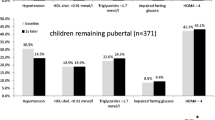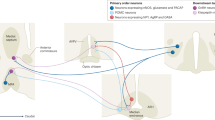Abstract
Puberty is a time of considerable metabolic and hormonal change. Notably, puberty is associated with a marked decrease in insulin sensitivity, on par with that seen during pregnancy. In otherwise healthy youth, there is a nadir in insulin sensitivity in mid-puberty, and then it recovers at puberty completion. However, there is evidence that insulin resistance (IR) does not resolve in youth who are obese going into puberty and may result in increased cardiometabolic risk. Little is known about the underlying pathophysiology of IR in puberty, and how it might contribute to increased disease risk (e.g., type 2 diabetes). In this review, we have outlined what is known about the IR in puberty in terms of pattern, potential underlying mechanisms and other mediating factors. We also outline other potentially related metabolic changes that occur during puberty, and effects of underlying insulin resistant states (e.g., obesity) on pubertal changes in insulin sensitivity.
Similar content being viewed by others
References
Papers of particular interest, published recently, have been highlighted as: • Of importance
Amiel SA, Sherwin RS, Simonson DC, et al. Impaired insulin action in puberty. A contributing factor to poor glycemic control in adolescents with diabetes. N Engl J Med. 1986;315(4):215–9.
Goran MI, Gower BA. Longitudinal study on pubertal insulin resistance. Diabetes. 2001;50(11):2444–50.
Hannon TS, Janosky J, Arslanian SA. Longitudinal study of physiologic insulin resistance and metabolic changes of puberty. Pediatr Res. 2006;60(6):759–63.
Bloch CA, Clemons P, Sperling MA. Puberty decreases insulin sensitivity. J Pediatr. 1987;110(3):481–7.
Moran A, Jacobs Jr DR, Steinberger J, et al. Insulin resistance during puberty: results from clamp studies in 357 children. Diabetes. 1999;48(10):2039–44.
Travers SH, Jeffers BW, Eckel RH. Insulin resistance during puberty and future fat accumulation. J Clin Endocrinol Metab. 2002;87(8):3814–8.
Caprio S, Plewe G, Diamond MP, et al. Increased insulin secretion in puberty: a compensatory response to reductions in insulin sensitivity. J Pediatr. 1989;114(6):963–7.
Ball GD, Huang TT, Gower BA, et al. Longitudinal changes in insulin sensitivity, insulin secretion, and beta-cell function during puberty. J Pediatr. 2006;148(1):16–22 [see comment].
Hoffman RP, Vicini P, Sivitz WI, et al. Pubertal adolescent male-female differences in insulin sensitivity and glucose effectiveness determined by the one compartment minimal model. Pediatr Res. 2000;48(3):384–8.
Reinehr T, Wolters B, Knop C, et al. Strong impact of pubertal status on metabolic health in obese children: a longitudinal study. J Clin Endocrinol Metab. 2014:jc20142674. The first longitudinal study to demonstrate a significant impact of puberty on cardiometabolic risk in obese youth.
Copeland KC, Zeitler P, Geffner M, et al. Characteristics of adolescents and youth with recent-onset type 2 diabetes: the TODAY cohort at baseline. J Clin Endocrinol Metab. 2011;96(1):159–67.
Dabelea D, Bell RA, D’Agostino Jr RB, et al. Incidence of diabetes in youth in the United States. JAMA. 2007;297(24):2716–24.
Guzzaloni G, Grugni G, Mazzilli G, et al. Comparison between beta-cell function and insulin resistance indexes in prepubertal and pubertal obese children. Metabolism. 2002;51(8):1011–6.
Roemmich JN, Clark PA, Lusk M, et al. Pubertal alterations in growth and body composition. VI. Pubertal insulin resistance: relation to adiposity, body fat distribution and hormone release. Int J Obes Relat Metab Disord. 2002;26(5):701–9.
Amiel SA, Caprio S, Sherwin RS, et al. Insulin resistance of puberty: a defect restricted to peripheral glucose metabolism. J Clin Endocrinol Metab. 1991;72(2):277–82.
Arslanian SA, Kalhan SC. Correlations between fatty acid and glucose metabolism. Potential explanation of insulin resistance of puberty. Diabetes. 1994;43(7):908–14.
Arslanian SA, Kalhan SC. Protein turnover during puberty in normal children. Am J Physiol. 1996;270(1 Pt 1):E79–84.
Dai S, Labarthe DR, Grunbaum JA, et al. Longitudinal analysis of changes in indices of obesity from age 8 years to age 18 years. Project HeartBeat! Am J Epidemiol. 2002;156(8):720–9.
Travers SH, Jeffers BW, Bloch CA, et al. Gender and Tanner stage differences in body composition and insulin sensitivity in early pubertal children. J Clin Endocrinol Metab. 1995;80(1):172–8.
Altwaijri YA, Day RS, Harrist RB, et al. Sexual maturation affects diet-blood total cholesterol association in children: Project HeartBeat! Am J Prev Med. 2009;37(1 Suppl):S65–70.
Morrison JA, Laskarzewski PM, Rauh JL, et al. Lipids, lipoproteins, and sexual maturation during adolescence: the Princeton maturation study. Metabolism. 1979;28(6):641–9.
Porkka KV, Viikari JS, Ronnemaa T, et al. Age and gender specific serum lipid and apolipoprotein fractiles of Finnish children and young adults. The Cardiovascular Risk in Young Finns Study. Acta Paediatr. 1994;83(8):838–48.
Tell GS, Mittelmark MB, Vellar OD. Cholesterol, high density lipoprotein cholesterol and triglycerides during puberty: the Oslo Youth Study. Am J Epidemiol. 1985;122(5):750–61.
Garcia-Mayor RV, Andrade MA, Rios M, et al. Serum leptin levels in normal children: relationship to age, gender, body mass index, pituitary-gonadal hormones, and pubertal stage. J Clin Endocrinol Metab. 1997;82(9):2849–55.
Ahmed ML, Ong KK, Morrell DJ, et al. Longitudinal study of leptin concentrations during puberty: sex differences and relationship to changes in body composition. J Clin Endocrinol Metab. 1999;84(3):899–905.
Arslanian S, Suprasongsin C, Kalhan SC, et al. Plasma leptin in children: relationship to puberty, gender, body composition, insulin sensitivity, and energy expenditure. Metabolism. 1998;47(3):309–12.
Blum WF, Englaro P, Hanitsch S, et al. Plasma leptin levels in healthy children and adolescents: dependence on body mass index, body fat mass, gender, pubertal stage, and testosterone. J Clin Endocrinol Metab. 1997;82(9):2904–10.
Andersen KK, Frystyk J, Wolthers OD, et al. Gender differences of oligomers and total adiponectin during puberty: a cross-sectional study of 859 Danish school children. J Clin Endocrinol Metab. 2007;92(5):1857–62.
Bottner A, Kratzsch J, Muller G, et al. Gender differences of adiponectin levels develop during the progression of puberty and are related to serum androgen levels. J Clin Endocrinol Metab. 2004;89(8):4053–61.
Tsou PL, Jiang YD, Chang CC, et al. Sex-related differences between adiponectin and insulin resistance in schoolchildren. Diabetes Care. 2004;27(2):308–13.
Xu L, Li M, Yin J, et al. Change of Body composition and adipokines and their relationship with insulin resistance across pubertal development in obese and nonobese Chinese children: the BCAMS study. Int J Endocrinol. 2012;2012:389108.
Luna AM, Wilson DM, Wibbelsman CJ, et al. Somatomedins in adolescence: a cross-sectional study of the effect of puberty on plasma insulin-like growth factor I and II levels. J Clin Endocrinol Metab. 1983;57(2):268–71.
Caprio S, Boulware D, Tamborlane V. Growth hormone and insulin interactions. Horm Res. 1992;38 Suppl 2:47–9.
Vijayakumar A, Yakar S, Leroith D. The intricate role of growth hormone in metabolism. Front Endocrinol. 2011;2:32.
Saenger P. Metabolic consequences of growth hormone treatment in paediatric practice. Horm Res. 2000;53 Suppl 1:60–9.
Barbour LA, Mizanoor Rahman S, Gurevich I, et al. Increased P85alpha is a potent negative regulator of skeletal muscle insulin signaling and induces in vivo insulin resistance associated with growth hormone excess. J Biol Chem. 2005;280(45):37489–94.
del Rincon JP, Iida K, Gaylinn BD, et al. Growth hormone regulation of p85alpha expression and phosphoinositide 3-kinase activity in adipose tissue: mechanism for growth hormone-mediated insulin resistance. Diabetes. 2007;56(6):1638–46.
Caprio S. Insulin: the other anabolic hormone of puberty. Acta Paediatr Suppl. 1999;88(433):84–7.
Guercio G, Rivarola MA, Chaler E, et al. Relationship between the GH/IGF-I axis, insulin sensitivity, and adrenal androgens in normal prepubertal and pubertal boys. J Clin Endocrinol Metab. 2002;87(3):1162–9.
Moran A, Jacobs Jr DR, Steinberger J, et al. Association between the insulin resistance of puberty and the insulin-like growth factor-I/growth hormone axis. J Clin Endocrinol Metab. 2002;87(10):4817–20.
Travers SH, Labarta JI, Gargosky SE, et al. Insulin-like growth factor binding protein-I levels are strongly associated with insulin sensitivity and obesity in early pubertal children. J Clin Endocrinol Metab. 1998;83(6):1935–9.
Ball GD, Weigensberg MJ, Cruz ML, et al. Insulin sensitivity, insulin secretion and beta-cell function during puberty in overweight Hispanic children with a family history of type 2 diabetes. Int J Obes (Lond). 2005;29(12):1471–7.
Pinhas-Hamiel O, Lerner-Geva L, Copperman NM, et al. Lipid and insulin levels in obese children: changes with age and puberty. Obesity (Silver Spring). 2007;15(11):2825–31.
Goran MI, Bergman RN, Avila Q, et al. Impaired glucose tolerance and reduced beta-cell function in overweight Latino children with a positive family history for type 2 diabetes. J Clin Endocrinol Metab. 2004;89(1):207–12.
Kelly LA, Lane CJ, Weigensberg MJ, et al. Pubertal changes of insulin sensitivity, acute insulin response, and beta-cell function in overweight Latino youth. J Pediatr. 2011;158(3):442–6.
Burns SF, Bacha F, Lee SJ, et al. Declining beta-cell function relative to insulin sensitivity with escalating OGTT 2-h glucose concentrations in the nondiabetic through the diabetic range in overweight youth. Diabetes Care. 2011;34(9):2033–40.
Giannini C, Weiss R, Cali A, et al. Evidence for early defects in insulin sensitivity and secretion before the onset of glucose dysregulation in obese youths: a longitudinal study. Diabetes. 2012;61(3):606–14.
Sjaarda LG, Bacha F, Lee S, et al. Oral disposition index in obese youth from normal to prediabetes to diabetes: relationship to clamp disposition index. J Pediatr. 2012;161(1):51–7.
Reinehr T, Toschke AM. Onset of puberty and cardiovascular risk factors in untreated obese children and adolescents: a 1-year follow-up study. Arch Pediatr Adolesc Med. 2009;163(8):709–15.
Agirbasli M, Agaoglu NB, Orak N, Caglioz H, Ocek T, Poci N, et al. Sex hormones and metabolic syndrome in children and adolescents. Metabolism. 2009;58(9):1256–62.
Basterfield L, Adamson AJ, Frary JK, et al. Longitudinal study of physical activity and sedentary behavior in children. Pediatrics. 2011;127(1):e24–30.
Nader PR, Bradley RH, Houts RM, et al. Moderate-to-vigorous physical activity from ages 9 to 15 years. JAMA. 2008;300(3):295–305.
Craggs C, Corder K, van Sluijs EM, et al. Determinants of change in physical activity in children and adolescents: a systematic review. Am J Prev Med. 2011;40(6):645–58.
Davis CL, Pollock NK, Waller JL, et al. Exercise dose and diabetes risk in overweight and obese children: a randomized controlled trial. JAMA. 2012;308:1103–12.
Nassis GP, Papantakou K, Skenderi K, et al. Aerobic exercise training improves insulin sensitivity without changes in body weight, body fat, adiponectin, and inflammatory markers in overweight and obese girls. Metabolism. 2005;54:1472–9.
Schmitz KH, Jacobs Jr DR, Hong CP, et al. Association of physical activity with insulin sensitivity in children. Int J Obes Relat Metab Disord. 2002;26(10):1310–6.
Nadeau KJ, Zeitler PS, Bauer TA, et al. Insulin resistance in adolescents with type 2 diabetes is associated with impaired exercise capacity. J Clin Endocrinol Metab. 2009;94(10):3687–95.
Regensteiner JG, Bauer TA, Reusch JE. Rosiglitazone improves exercise capacity in individuals with type 2 diabetes. Diabetes Care. 2005;28(12):2877–83.
Marshall WA, Tanner JM. Variations in pattern of pubertal changes in girls. Arch Dis Child. 1969;44(235):291–303.
Marshall WA, Tanner JM. Variations in the pattern of pubertal changes in boys. Arch Dis Child. 1970;45(239):13–23.
Author information
Authors and Affiliations
Corresponding author
Ethics declarations
Conflict of Interest
Megan M. Kelsey and Philip S. Zeitler declare that they have no conflict of interest.
Human and Animal Rights and Informed Consent
This article does not contain any studies with human or animal subjects performed by any of the authors (other than previously published studies that are referenced within).
Additional information
This article is part of the Topical Collection on Pediatric Type 2 Diabetes
Rights and permissions
About this article
Cite this article
Kelsey, M.M., Zeitler, P.S. Insulin Resistance of Puberty. Curr Diab Rep 16, 64 (2016). https://doi.org/10.1007/s11892-016-0751-5
Published:
DOI: https://doi.org/10.1007/s11892-016-0751-5




